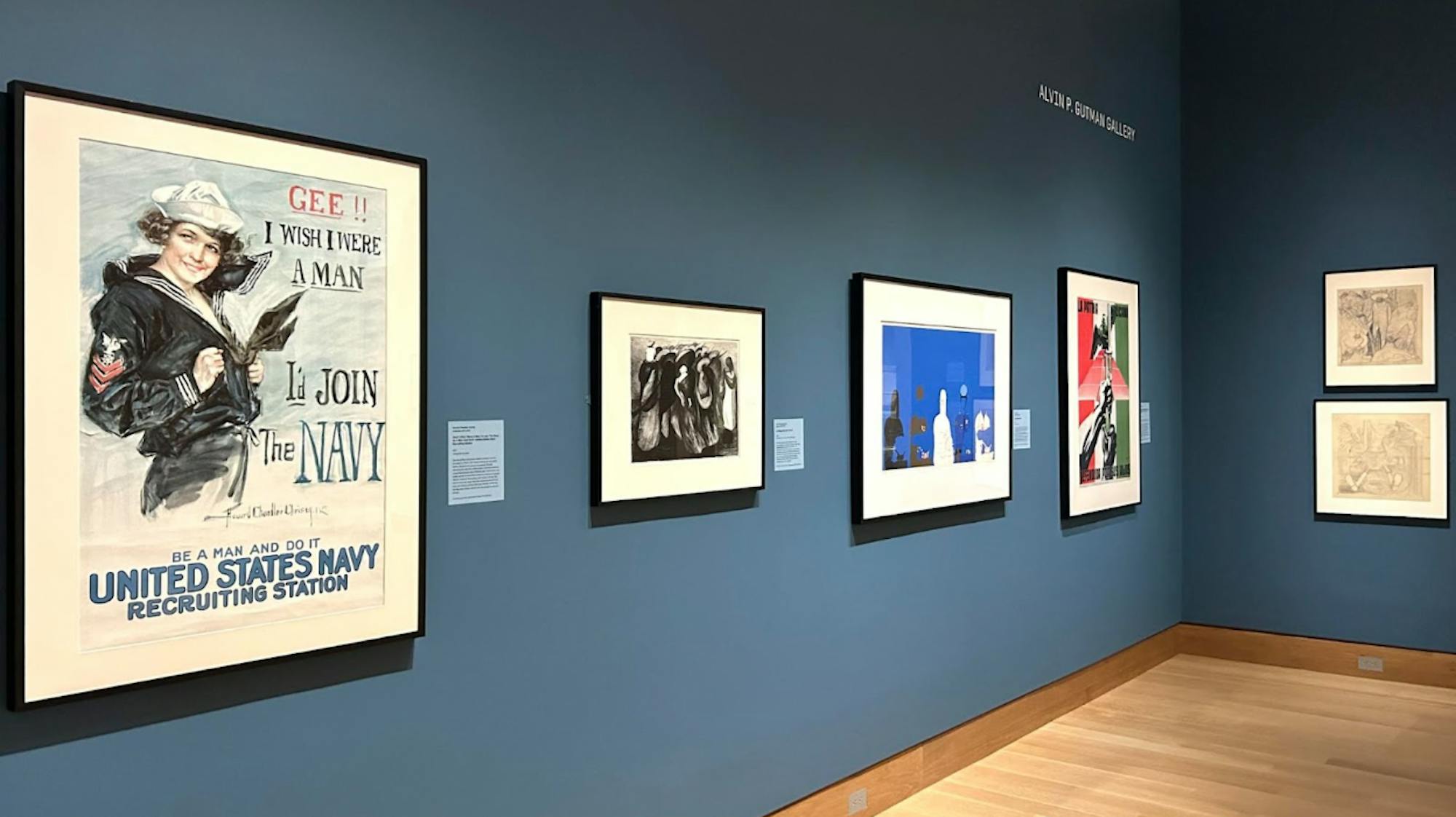On Jan. 25, the Hood Museum of Art debuted its 110th “A Space for Dialogue” exhibition, titled “Constructing the Ideal Soldier.” Nathan Savo ’24, a Class of 1954 curatorial intern at the Hood, was the primary curator for the exhibition, which examines art from Mexico and the United States during the first half of the 20th century. The exhibition encourages viewers to consider the ways in which different conventions of gender and patriotism were either upheld or challenged when depicting service members in art.
“Constructing the Ideal Soldier” consists of eight artworks, three of which are World War I and II-era posters. The remaining works either contradict or question the patriarchal values and gender stereotypes portrayed in the posters.
Savo said that the juxtaposition of the works is a meditation on what it means to be a soldier.
“[The exhibition] explores how artists have constructed our societal conception of what a soldier is and, more importantly, what a soldier should be,” Savo said.“This construction of the ideal service member often framed the soldier figure as a heroic, patriotic, heterosexual man, which not only served to reinforce heteronormative and patriarchal societal values but also unrestrained nationalism.”
One of the selected works is a World War I recruitment poster for the United States Navy entitled “Gee!! I Wish I Were A Man, I’d Join The Navy,” by Howard Chandler Christy. The work depicts a woman dressed in a sailor’s uniform whose image conforms to the beauty standards of that era, suggesting that the poster intends to grab the attention of a heterosexual male. This intended target audience is supported by the text on the poster that states “Be man and do it,” further reinforcing that the ideal soldier is a male recruit.
Posters within the exhibit that uphold gender stereotypes, including Christy’s, are juxtaposed with artworks such as “Big Daddy Paper Doll,” created by May Stevens. The work features a male paper doll with a head shaped like a bullet. The figure is surrounded by uniforms of stereotypically masculine occupations, including an executioner, soldier, police officer and butcher. In her work, Stevens exposes how violence and patriarchy result from the permeating societal standards of what it means to be a man.
As a part of the exhibition series, “Constructing the Ideal Soldier” strives to provide a platform for students to explore their interests while sparking discourse throughout the Dartmouth community. Amelia Kahl, the Barbara C. & Harvey P. Hood 1918 Curator of Academic Programming, said that Savo’s project is an exemplary embodiment of the goals of the series.
“[Savo is] bringing out objects that we haven’t seen that often, he’s putting things together that have never been shown before, and then he’s using this really interesting theoretical lens of... how gender intersects with military service within these objects,” Kahl said.
Savo said he worked with Michael Hartman, the Associate Curator of American Art at the Hood, to sort through its collection of over 65,000 objects to create what Savo described as a “visual essay.”
The exhibition includes works from artists such as Joseph Renau, Christy and Stevens in addition to “The Epic of American Civilization” muralist José Clemente Orozco.
This exhibit drew inspiration from a project Savo had done in his first year at Dartmouth for the class ARTH 40.02: “The American Century: 20th Century Art from the United States,” taught by art history professor Mary Coffey. Savo recalled walking away from the assignment with lingering questions. Through “Constructing the Ideal Soldier,” Savo said he was able to incorporate his past studies with a new angle by analyzing the soldier figure through the lens of gender.
Savo said he hopes that visitors of “Constructing the Ideal Soldier” will consider the ways in which visual media can impact social constructs, adding that visitors should realize that such ideas are not limited to the early 20th century and continue to be significant today.
“Ultimately, things like Marvel movies, Captain America and an ad you might see for the National Guard on Youtube [are] visual culture [that] saturates our lives and my main takeaway that I want people, when they visit, to think about is how contemporary visual culture continues to contribute to our idea of what a soldier is,” Savo said. “I want them to be a little bit more critical when analyzing the strategies used in these ads.”
According to Hartman, the Hood emphasizes student involvement in the arts and hopes to provide accessible resources to invite new points of view and embolden students to take part in conversations in a variety of ways. While working with Savo on “Constructing the Ideal Soldier,” Hartman noted the significance of incorporating student voices.
“It was fun for me to work with [Savo] because our interests align in some ways and he is able to bring something to these works through his own background,” Hartman said. “The perspective that he brings to it isn’t going to be the perspective that I would necessarily bring or that anyone else would bring.”
Reflecting on his experience of crafting this exhibition during his talk, Savo said that he encouraged his audience to further engage with the Hood, noting the immersive experience he had as a student intern.
“Ultimately, planning this exhibition was one of the most rewarding experiences I’ve had as a student at Dartmouth,” Savo said.




